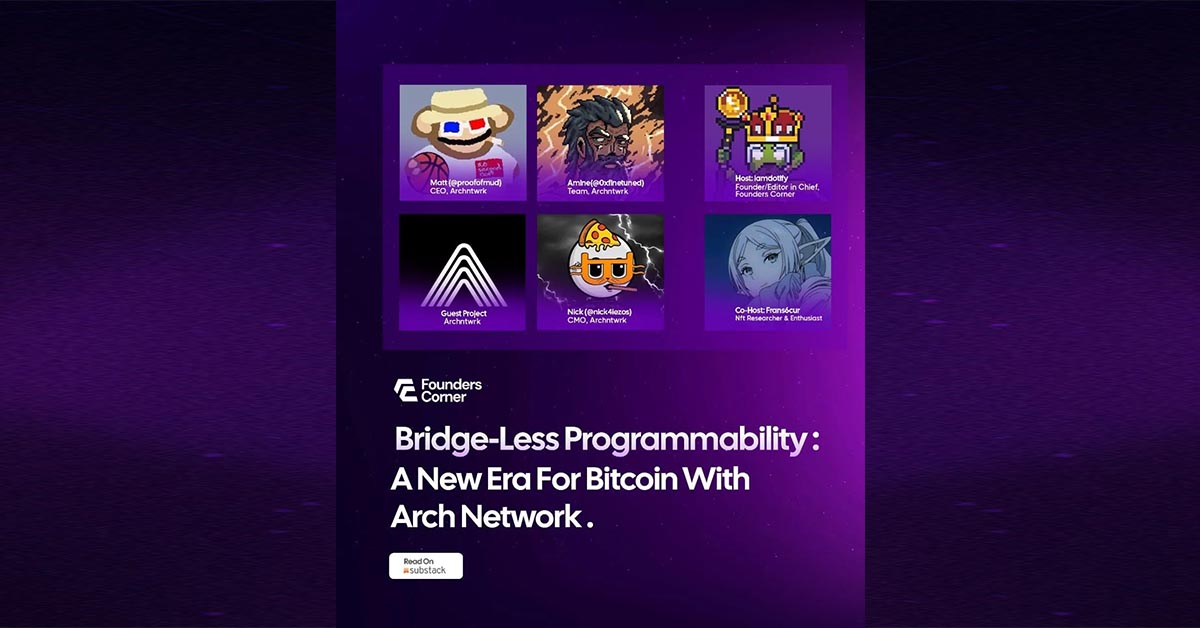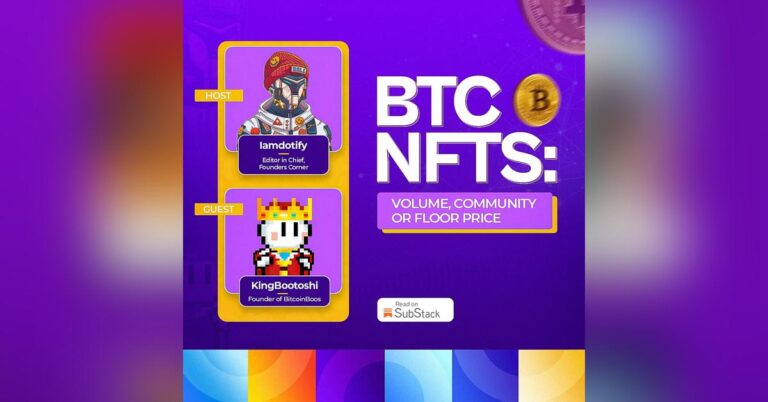Today on Founders Corner, we’re thrilled to host an inspiring conversation with Matt and Nick, the visionaries behind Arch Network – a groundbreaking project reshaping how Bitcoin integrates with decentralized finance (DeFi).
THE ARCH NETWORK POSITIONS ITSELF AS A BRIDGE-FREE SOLUTION FOR ENABLING BITCOIN PROGRAMMABILITY. WHAT INSPIRED THE DECISION TO BUILD A BRIDGELESS PLATFORM INSTEAD OF ENHANCING EXISTING LAYER 2 SOLUTIONS OR META-PROTOCOLS?
Well, at its core, the goal of Arch Network is to unlock a complete DeFi experience directly on Bitcoin’s base layer. Over the past year, we’ve seen numerous attempts to enable smart contract programmability and create a Bitcoin-native DeFi ecosystem. However, every existing solution has required bridging to a Layer 2 or wrapping Bitcoin into a meta-protocol—approaches that fundamentally differ from how Arch operates.
So Arch Network introduces its own blockchain, virtual machine (VM), and consensus mechanism that all specifically designed to create a seamless and native Bitcoin experience. Unlike other solutions such as Stacks or EVM-compatible platforms like Bitlayer and Bob, Arch’s VM does not rely on EVM rollups or bridging mechanisms. Instead, it integrates directly with Bitcoin, offering developers more performance and scalability while ensuring a truly native experience for users.
Note that bridges have historically been the most exploited areas in the crypto space. The inherent vulnerability arises from the fact that different blockchains, like Ethereum and Bitcoin, don’t natively communicate. Bridging introduces significant friction and requires users to trust intermediaries.
But Arch solves this problem by allowing users to self-custody their Bitcoin and interact directly with the Arch Network without bridging or wrapping their assets. Whether you are using wallets like Ledger, Magic Eden, Xverse, or Unisat, users retain full control of their Bitcoin while benefiting from the programmability offered by Arch’s VM. This approach protects the foundational security and liquidity of Bitcoin while expanding its capabilities into the realm of DeFi and beyond.
GIVEN BITCOIN’S UNPARALLELED SECURITY AND LIQUIDITY, HOW DOES ARCH ENSURE THAT PROGRAMMABILITY DOESN’T COMPROMISE THESE FOUNDATIONAL STRENGTHS?
Really, Arch achieves this by leveraging Bitcoin-native scripting and transactions, such as Partially Signed Bitcoin Transactions (PSBTs) and UTXOs, to manage state and execute a hybrid system of account states. This ensures that users are only trusting Bitcoin, not Arch, while still accessing advanced programmability features.
The core innovation lies in how Arch’s VM operates. It generates native Bitcoin transactions, so from the perspective of a Bitcoin miner, what they see is a peer-to-peer transaction. However, beneath the surface, Arch’s VM is executing complex computations via smart contracts. This allows for advanced functions like liquidity pools and asset transfers directly on the Bitcoin base layer. The smart contract enables these state transitions and asset movements, all without altering Bitcoin’s foundational peer-to-peer architecture.
Unlike other programmable ecosystems (e.g., Ethereum, Solana, or Sui), Bitcoin lacks inherent support for Turing-complete smart contracts or pooled asset management. Arch bridges this gap by introducing conditional execution via its decentralized Frost and Roast multisig system, which operates similarly to Ethereum or Solana’s decentralized frameworks and is secured through Proof-of-Stake economic security.
This architecture enables users to interact with decentralized liquidity pools in a trust-minimized way. While liquidity pool depositors may trust Arch to some extent, the majority of users (such as takers swapping assets in a DEX) operate trustlessly. For instance, when a user initiates a swap, they sign a PSBT generated by Arch’s VM. The user knows exactly what they are receiving in return, with no need to trust Arch.
The primary distinction between Arch and other solutions like Bitlayer or Bob lies in asset management. Layer-2s like Bitlayer change state within their own ecosystem without interacting directly with the Bitcoin base layer. In contrast, Arch facilitates actual UTXO movements and asset shuffling directly on Bitcoin, enabling a native experience unmatched by other Layer 2 solutions.
HOW DOES ARCH MANAGE POTENTIAL BOTTLENECKS CAUSED BY BITCOIN’S SLOW BLOCK TIMES, YOU KNOW OF COURSE BITCOIN HAS ACTUALLY BEEN A LITTLE BIT SLOW THESE DAYS AND IT TAKES TIME FOR THE USER TO GET THEIR FUNDS, SO HOW DOES ARCH PLAN TO FIND THEIR WAY AROUND THAT?
The thing is, Arch has implemented several innovations to address the limitations imposed by Bitcoin’s block times and improve scalability and user experience.
Firstly, Arch introduces what we call “state-only transactions.” These transactions allow activity to occur entirely within the Arch network without needing to submit every transaction back to Bitcoin. This enables the network to operate at its own speed, independent of Bitcoin’s block intervals, providing users with faster interactions.
Let me add to what Nick just highlighted by letting you know that another core innovation is the architecture of Arch’s VM. Unlike Ethereum’s EVM, which relies on sequential execution in a global state, Arch’s VM is designed for parallel execution, similar to Solana’s approach. By processing non-overlapping states in parallel, Arch achieves significantly higher throughput. This design allows Arch to overcome bottlenecks associated with Bitcoin’s inherent limitations, such as slow block confirmation times.
In addition to what Matt said, Arch employs a state-sharding technique. For example, in the Saturn launch, we split pool states into multiple shards. Instead of managing all states within a single account, the system distributes states across shards. When performing an operation like a swap, only the relevant state is updated, while other states are read as needed. This sharding technique allows Arch to bypass Bitcoin’s “descendant limit,” which restricts a UTXO to 25 chained transactions. By using 50 shards, Arch effectively scales transaction capacity to 50 times the descendant limit, with potential for further scaling as demand grows.
To further enhance performance, Arch also integrates mempool indexing and intra-block trading. This allows Arch to pre-confirm states from the mempool, enabling rapid confirmations and reducing the need to wait for a block to finalize. Users benefit from near-instantaneous trading, creating an experience comparable to high-performance networks like Solana.
CAN YOU FURTHER EXPLAIN MORE ON WHAT INSPIRED THE DECISION TO BUILD UP A DIFFERENT THING INSTEAD OF COLLABORATING WITH THE EXISTING PROTOCOLS THAT WE HAVE DONE ALREADY?
At Arch, we believe that the existing protocols made a fundamental misstep by assuming that EVM-based solutions would scale Bitcoin DeFi. These solutions focus on taking Bitcoin away from its native blockchain to participate in other programmable environments. We see this approach as counterintuitive. Our mission is to use Bitcoin as a technology—leveraging recent upgrades like Taproot, Ordinals, and Inscriptions—to bring DeFi to Bitcoin itself, rather than taking Bitcoin out of its ecosystem.
Existing Layer2s and meta-protocols prioritize moving Bitcoin assets away from the Bitcoin blockchain which often reduces fees for miners and rely on wrapped Bitcoin solutions to operate in other ecosystems. Historically, as we know it, this model has failed to resonate with Bitcoin users. For example, despite the existence of solutions like Wrapped Bitcoin (wBTC) and Threshold Bitcoin (tBTC) on Ethereum for over five years, less than 1% of all Bitcoin has ever migrated to Ethereum. Why? This is because Bitcoin holders want to remain within the Bitcoin ecosystem—they don’t want to use MetaMask, trust Ethereum, or rely on bridges.
So let me ask you, if users have not embraced bridging their Bitcoin to Ethereum, which offers real liquidity and established DeFi protocols like Curve and Uniswap, why would they now move their Bitcoin to smaller Layer 2s like Bitlayer, Bob, or Botanix? These platforms offer far less liquidity (e.g., $200M compared to Ethereum’s $330B) and fundamentally fail to address Bitcoin users’ core desires: to transact and participate natively on Bitcoin itself.
At Arch, we’re focused on enabling Bitcoin users to participate in DeFi natively. Instead of fragmenting liquidity or introducing unnecessary trust points, we integrate directly with Bitcoin, allowing users to sign Bitcoin transactions without compromising control over their assets. We believe that if existing Layer 2 solutions want to tap into Bitcoin’s native liquidity, they’ll need to integrate with Arch—not the other way around.
COULD YOU GIVE A CONCRETE EXAMPLE OF HOW THIS ARCH NETWORK ENHANCES DECENTRALIZED FINANCE APPLICATION ON BITCOIN? I AM TRYING TO GET ONE OR TWO USE CASES OF THE NETWORK AND THE DEVELOPMENT IT DOES FOR THE ECOSYSTEM AT LARGE WHEREBY EVERY SINGLE INDIVIDUAL IN THE BITCOIN ECOSYSTEM CAN GET TO ENJOY FROM THE DIVIDEND OF WHAT YOU GUYS ARE BUILDING.
A prime example of how the Arch Network enhances DeFi on Bitcoin is through its delegated proof-of-stake (DPoS) model. This system allows everyday users to actively participate in securing the network while earning yield. Here’s how it works and why it’s transformative:
Staking for Yield:
i. Users who hold the Arch token can delegate their stake to validators within the network, much like how Solana operates. These validators are responsible for securing the network and processing transactions. By staking their Arch tokens, users earn a share of the network’s rewards, creating an accessible and sustainable yield-generation mechanism for all participants.
ii. Currently, Arch boasts over 26 validators, including reputable names like Galaxy, Egdevana, Luganodes, and Blockdaemon. These are well-established entities that have staked billions of dollars in other prominent ecosystems such as Solana, Aptos, and Sui. This robust validator ecosystem ensures a high level of trust and security.
Decentralized Verifier Network:
i. Unlike many existing solutions that rely on centralized or semi-centralized models (e.g., two-of-three multisig setups), Arch employs a completely decentralized verifier network. Execution on the network requires achieving an “honest majority,” where decisions are collectively made by the validators. This ensures that no single entity or small group can manipulate outcomes.
ii. Importantly, Arch removes itself entirely from the execution process. Instead of relying on Arch directly, users trust a network of proven validators who have demonstrated goodwill and reliability across various blockchain ecosystems.
Use Case: Enabling Secure and Trustless Trading:
i. For example, a user might want to engage in decentralized trading on Bitcoin without relying on bridges or wrapped tokens. Arch enables this by allowing smart contracts to directly handle Bitcoin transactions using native UTXO logic. This eliminates the need for users to relinquish custody of their assets or bridge them into another blockchain.
ii. As a result, users can access advanced DeFi applications such as swaps, liquidity pools, and yield farming natively on Bitcoin, preserving the security and transparency of the Bitcoin base layer while enjoying the programmability and flexibility that Arch unlocks.
Community and Ecosystem Benefits:
i. The DPoS model not only enhances network security but also democratizes participation in DeFi. Everyday users can earn rewards while supporting the network, creating a more inclusive and accessible ecosystem.
ii. Additionally, by decentralizing execution and relying on trusted validators, Arch fosters greater confidence among users, which is critical for scaling Bitcoin-native DeFi solutions.
WHEN YOU SAID THAT YOU ARE GOING TO GIVE DEVELOPERS A WAY TO GIVE THEIR USERS A MORE NOVEL DEFI EXPERIENCE, JUST LIKE WHAT YOU’RE DOING WITH SATURN NOW, ARE YOU ALSO GOING TO SHARE YOUR TECHNOLOGY WITH OTHER APPLICATIONS AND OTHER PRODUCTS ON BTC SO THAT THEY CAN MOVE THEIR DEFI ACTIVITIES TO BITCOIN ITSELF AND NOT THE OTHER LAYER2S OR LIKE EVM INTEGRATED?
Absolutely! At Arch, our goal is to empower developers to create diverse and innovative DeFi applications natively on Bitcoin. Saturn, our first decentralized exchange (DEX), is just the beginning. The technology and infrastructure we’ve built are open-source, meaning developers are free to utilize them however they see fit. This approach ensures flexibility, creativity, and widespread adoption. Here’s how this works in practice:
Developer Freedom and Flexibility:
i. Developers can create applications tailored to their vision. For example, Saturn offers a highly native Bitcoin DEX experience, while other projects like Funkybit are exploring cross-chain trading and high-frequency trading experiences.
ii. Developers can even create hybrid models, similar to rollups, where state is managed off-chain but periodically posted back to Bitcoin for security and finality. This “Choose Your Own Adventure” approach allows for innovation without sacrificing the integrity and security of Bitcoin.
Composability and Interoperability:
i. Arch’s architecture ensures that all applications built on the network—whether they are native or less native—remain interoperable. This composability is crucial for creating seamless user experiences.
ii. For instance, on Ethereum, users interact with protocols like Aave through many integrated applications, leveraging composability. Arch aims to replicate this kind of interconnected ecosystem on Bitcoin, avoiding the fragmentation seen in Layer 2 solutions.
Network Effect for DeFi on Bitcoin:
i. A major challenge in Bitcoin DeFi today is the fragmentation of liquidity and state across various protocols. Arch aggregates liquidity and state into a unified network, fostering synergy between applications.
ii. This is similar to the network effect that powered DeFi Summer 2020 on Ethereum, where lending, borrowing, and DEX protocols interconnected to create a vibrant and innovative ecosystem. Arch is building the infrastructure to enable this kind of growth on Bitcoin.
Real-World Use Case:
i. Let’s say a developer wants to build a prediction market or a high-performance perpetual DEX. Using Arch’s state-only execution model, they can achieve the required throughput without sacrificing Bitcoin’s security. Unlike projects like Valar on Stacks, which are isolated, an Arch-based application would enjoy full interoperability with other Arch applications, ensuring a cohesive user experience.
DOES THE ACT TOKEN AND PROOF OF STAKE NOW COME IN PLACE AS A GOVERNANCE TOKEN TO HELP EXPAND MORE ON THE OPEN PROTOCOL THAT ARCH IS BUILDING OR WHAT EXACT ROLE WOULD THE ACT TOKEN PLAY?
The Arch token plays multiple roles, but its most crucial function is ensuring the economic security of the network. Here’s how it works:
Economic Security via Staking:
i. Validators are required to stake ACT tokens to participate in the network. Their stake serves as collateral, ensuring that only those who have invested in the network’s security and infrastructure are allowed to validate transactions.
ii. The more ACT a validator stakes, the more weighted their role in transaction signing, similar to Solana’s delegated proof-of-stake model.
Incentivizing Validators:
i. Validators earn rewards for securing the network and maintaining its infrastructure. These rewards come from inflationary emissions of the ACT token.
ii. Users initiating transactions pay a gas fee in ACT. This gas fee is burned, which over time could lead to a deflationary dynamic if the burn rate surpasses the emissions rate.
Governance Potential:
i. While governance isn’t the primary focus at this stage, ACT token holders will eventually have voting privileges. This will allow the community to make decisions on protocol upgrades and other important matters as the network grows.
ii. For now, governance will play a minor role, as the focus is on building the network and fostering adoption.
Gas Token for Transactions:
ACT is used as the gas token to pay transaction fees within the Arch Network. This makes it integral to the functionality of the ecosystem.



